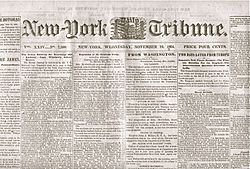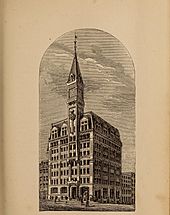New-York Tribune facts for kids
 |
|

Front page of the New-York Tribune no. 7,368
November 16, 1864 |
|
| Type | Daily newspaper |
|---|---|
| Format | Broadsheet |
| Founded | 1841 |
| Ceased publication | 1924; merged with New York Herald to form the New York Herald Tribune |
| Headquarters | Manhattan, New York, New York, U.S. |
The New-York Tribune was an American newspaper. It was started in 1841 by an editor named Horace Greeley. For a while, from 1842 to 1866, it was called the New-York Daily Tribune. Then it went back to its original name.
From the 1840s to the 1860s, it was a very important newspaper. It supported the Whig Party first. Later, it supported the Republican Party. In the 1850s, about 200,000 copies were printed each day. This made it the biggest daily newspaper in New York City at that time.
The Tribunes articles and opinions were read by many people. Other newspapers often copied them. This helped to shape what people across the country thought. It was one of the first newspapers in the northern U.S. to send reporters and artists to cover the American Civil War. The newspaper continued to be published every day until 1924. Then, it joined with the New York Herald. They formed a new paper called the New York Herald Tribune, which was published until 1966.
Some famous people who worked on the paper's editorial team included Bayard Taylor, George Ripley, and Isidor Lewi.
The famous poem "Annabel Lee" by Edgar Allan Poe was first printed in this newspaper. It appeared on October 9, 1849, as part of his obituary. Another poem by Poe, "The Bells", was also published in the paper on October 17, 1849.
Contents
The Tribune's Early Days


Horace Greeley started the Tribune in 1841. He wanted to create a newspaper that was honest and easy to trust. Before this, Greeley had published a weekly newspaper called The New Yorker. He also published a political newspaper for the Whig Party called Log Cabin. In 1841, he combined these two papers to create the New-York Tribune.
Greeley supported many changes in society. He believed in pacifism (being against war) and feminism (equal rights for women). He especially believed in the idea of hard-working, free people. Greeley wanted reforms to make all citizens free and equal. He imagined good citizens who would get rid of corruption. He often talked about progress, improvement, and freedom. He also called for workers and business owners to get along.
Greeley's articles promoting social changes were printed everywhere. They influenced the ideas of the Whig Party and the Republican Party.
To help promote these changes, Greeley hired many writers who later became famous. These included Margaret Fuller, Charles Anderson Dana, and Henry Jarvis Raymond. Raymond later helped start The New York Times. From 1852 to 1862, the paper even hired Karl Marx as its reporter in London. Friedrich Engels also wrote articles for the paper.
How the Tribune Influenced Politics
The Tribune was started during a time of big changes in the country. In 1854, the paper joined the new Republican Party. It was named after the party of Thomas Jefferson. The newspaper strongly opposed slavery.
The paper became very popular, with about 200,000 copies printed daily in the 1850s. This made it the most widely read newspaper in New York City. Because of this, it had a lot of influence on voters and political leaders. During the Civil War, Greeley strongly fought against slavery. He criticized the Democrats and called for the first mandatory draft of soldiers in the U.S. This led to a group of people trying to burn down the Tribune building during the Draft Riots.
Greeley ran for president in 1872. He was the candidate for the Liberal Republican Party and the Democratic Party. He ran against the current president, Ulysses S. Grant. Greeley lost the election. Soon after, he became ill and died a few weeks later. After Greeley's death, Tribune editor Whitelaw Reid bought the newspaper.
In 1886, with Reid's help, the Tribune became the first newspaper in the world to use a linotype machine. This machine was invented by Ottmar Mergenthaler. This new technology allowed the paper to print more than the usual eight pages. It also made printing much faster, so more copies could be made.
The New York Herald Tribune
Ogden Mills Reid, the son of Whitelaw Reid, took over the paper. In 1924, he bought and merged it with the New York Herald. This created the New York Herald Tribune. Ogden M. Reid continued to run the New York Herald Tribune until he died in 1947.
Where the Tribune Buildings Are Today
- The New York Tribune Building was the first home of Pace University. Today, the place where that building stood is now the One Pace Plaza complex. This is part of Pace University's campus in New York City.
- On December 15, 1921, The New York Tribune bought two plots of land at 219 and 220 West 40th Street. The building that The New York Tribune built there is now home to the City University of New York Graduate School of Journalism.
Finding Old Tribune Articles
You can find copies of the New-York Tribune on microfilm at many large libraries. They are also available online at the Library of Congress. The Library of Congress website also has indexes for some years from the late 1800s. The original articles from the newspaper's old files are kept at The Center for American History at the University of Texas at Austin.
See also
 In Spanish: New York Tribune para niños
In Spanish: New York Tribune para niños

